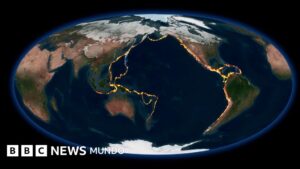In the absence of knowing the small print of the commercial agreement signed by Donald Trump and Ursula von der Leyen, the pact reveals the surrender of the European Union to the excesses of the White House tenant, both in the background and in the form. The president of the European Commission agreed to move to the golf course in Scotland where the tycoon spent a few days of private leisure to close the agreement. The details had been outlined in recent days and the trip occurred when the discount time was entered for the boundary of August 1 that Trump had put to avoid his last threat: a 30% generic tariff that in Brussels had described as “prohibitive”. By then, countries like Germany had made it clear that they were willing to practically everything to reach an agreement.
And in the end Trump has come out with his. For the first time in decades, it manages to seal commercial understandings that, in practice, suppose an increase in transactions. Now, only in one direction. The EU also undertakes to substantially increase its imports to that country, whose complaint is the existence of a commercial deficit much lower than the promises that have launched von der Leyen. The EU is formed with the least bad.
15% tariffs on EU exports
The great holder of the agreement is that US exports to the US will have a 15% tax with a general character. It is a great triumph for Trump, which makes the EU accept that figure that was initially unassumable and that has already been applying, in fact, for a couple of months. And in the EU they had said that they were unfair, disproportionate and illegal rates. However, now assumes them. In fact, before starting the meeting on the margins of the golf course, von der Leyen has recognized that there was an imbalance in commercial relations that harmed the US.
However, in the EU they had encrypted that amount at 236,000 million euros that remain at 50,000 million if the services are counted – of total transactions of approximately 1.5 billion euros – and promised to adjust it by increasing some imports while advocating the introduction of 'zero' zero tariffs for vehicles and non -industrial products.
“They have agreed to open their countries to trade with zero tariffs. That is a very important factor. When opening their countries, they will all be open to trade with the United States with zero tariffs,” Trump presumed over the 27 EU members.
Save European industries?
Speaking to journalists after the meeting, von der Leyen has referred “zero tariffs for a series of strategic products”, among which has cited airplanes and their components (especially important for companies such as Airbus or Boeing), “certain chemical products, certain generic medicines, semiconductor equipment, certain agricultural products, natural resources and essential raw materials”.
And it has put in value that the “unique tariff of 15%” by the US will apply to most sectors, “including cars, semiconductors and pharmaceutical products.” Justification to a good extent is that this gives certainty to companies at “turbulent”.
And why sells it as a victory if it is an exponential increase on what there was before Trump? Because von der Leyen does the 'trap' of comparing that figure with what had been applied since the US president unleashed the commercial war and that in the case of vehicles it was 25% extra to the previous 2.5%. Therefore, he considers it a decrease.
“We must not underestimate 15%, but it is the maximum we could get,” he admitted. And the same goes for the threat that overwhelmed with the semiconductors and the pharmaceutical sector, keys to states such as Netherlands or Ireland.
Tariff reduction paid
In addition to the EU assumes more tariffs by the US, it undertakes to reduce some of which the community block imposes, such as the 2.5% rate to vehicles from that country. Thus, imports will have a 0% tax while exports will have it 15%.
The EU will also eliminate tariffs that currently impose on some agricultural products, such as nuts, which will cease to be taxed; Lobster or other fish, in addition to cheese and some dairy products. Pet food will also be included. The final list will be published next to the joint declaration of the agreement between the two blocks, according to community sources, which encrypts the products that will have zero tariffs at 70,000 million.
The EU knelt after the NATO Summit
Just a month ago it was clear at the Hague Summit that NATO members succumb to Trump's pressure – which came to the White House threatening to dynamit the alliance – by accepting a new goal of military spending of 5% of GDP. Many European countries, including Germany, acknowledged that it was an incompatible threshold with public finances, but complied with it, with the exception of Pedro Sánchez, who said that Spain would fulfill its commitments to NATO without reaching that figure.
Now Trump gets the EU to commit to that part of that expense goes to the US arms industry. “They have agreed to buy a lot of military team. We do not know what that figure is, but the good news is that we manufacture the best military team in the world,” said the US president, who has linked it with NATO and, in fact, has admitted that there are not many differences between the EU and what the alliance represents as a whole.
Threat as a new diplomatic manual in the world
The agreement with Trump arrives after he published on his social networks 20 days ago a letter to Ursula von der Leying informing him that he applied a 30% tariff to European products. A decision that came as a result of that famous independence day of the United States, on April 2, which advanced tariffs worldwide.
The US president has played threats with his European partners, and has been victorious. Trump has implemented a new diplomatic pattern, which goes through threatening trade to, from there, to achieve a good agreement for their interests. And he is getting it.
For a few months the expression “Trump Always Chickn Out”, Taco, Tacump always rays circulated in Washington. But, in the end, those who are ending cracking are the rest of the countries in the world.
Except Canada, Brazil and China, the rest are entering the threat game, the frame proposed by Trump and its conditions.
The era of dialogue, multilaterality and alliances between the US and the EU, blocks with similar ways of conceiving the world, has given way to threats and coercion.
Energy purchases for almost half of consumption
Trump's other great victory is that the EU undertakes to substantially increase US energy imports. Thus, the president has spoken of 750,000 million dollars (about 680,000 million euros) that Von der Leyen has specified that they will materialize in three years, that is, 250,000 million each year (about 225,000 million euros).
This figure is very high considering that EU energy imports to third countries amounted to 427,000 million euros in 2024, according to the European Commission data. We will replace Russian gas and oil with significant purchases of American GNL gas, oil and nuclear energy, ”Von der Leyen confirmed.
And energy autonomy?
One of the alleged lessons learned from the invasion of Ukraine by Vladimir Putin was Russia's excessive energy dependence. The Nord Stream, the cheap gas for the German industry, the positions for former European leaders in Gazprom, such as the former Social Democratic Chancellor Gerhard Schröder, and a whole series of obligations with Russia in exchange for sustained growth in a cheap energy jumped through the air after February 2022.
The Pandemia of the Covid, together with the Ukraine War, made the European Union aware of their units and weaknesses with respect to the outside. And it was decided to cut with Russian energy and invest in energy autonomy through renewables.
All that now, with the agreement with the US, is called into question, while the commitment is to bring from another continent a third of the European annual consumption: that is, a third of the energy consumed by Europeans will depend on one country in another continent, with what this means of loss of autonomy, own resources and bets on an itinerary of European energy transition.
And, in addition, the agreement is with a country, the US, whose president, Donald Trump, has as its energy compass the “Drill, Baby Drill”, which is pure extractivism and nuclear, while opening coal mines, which in Europe are synonymous with polluting energies, contrary to the environment, faces and little sustainable.
Signature von der Leyen, but the 27 are behind
The president of the European Commission, Ursula von der Leyen, has sealed the agreement this Sunday afternoon in Donald Trump's Scottish golf course. It has moved there from Brussels to formalize an agreement that raffles a commercial war, but also shows a dominant Trump position on the European Union.
Trump has gone to war, has imposed unilateral tariffs, wanting to use taxes to end imbalances in commercial scales that have more to do with the competitiveness of companies and products that with barriers to the circulation of goods.
And the EU has not responded with the same currency: it has preferred an agreement, even if it was bad, than a commercial war. And that is not a unique decision of the European Commission, in whom the competences of international trade in the EU fall, but it is something that has the approval of the 27, which have been informed and consulted constantly by the Community Executive.
And what they have decided the 27 is that they did not want a war, which preferred a bad agreement to a non -agreement. And that is what they have achieved: they have signed, for the first time, to assume unilateral tariffs by the US.
Steel, aluminum and copper, 50%
There is something that does not enter the European agreement of 15%, and they are aluminum, steel and copper, subject to 50% generalized for imports to the US.
Despite the European efforts to reduce that entrance wall to the US market decreed unilaterally by Donald Trump, the agreement signed by Ursula von der Leyen does not apply to these fundamental raw materials for the US industry.






